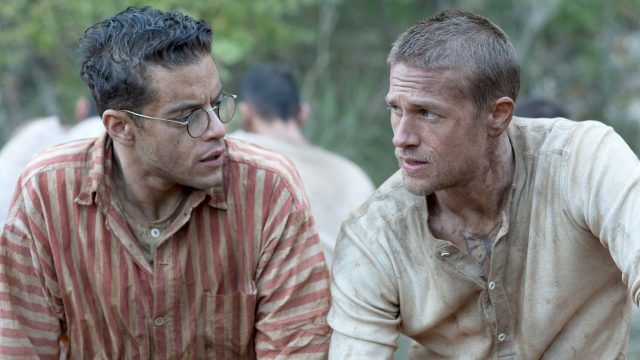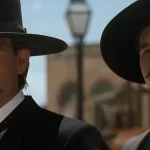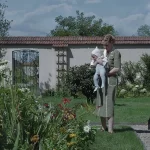Papillon: More of a Moth, by Jim Rohner
Imagine, if you will, a version of Goodfellas that still stars Lorraine Bracco as Karen Hill but which has swapped out Ray Liotta for Christopher Lambert. The energetic and emotionally complex performance that nabbed Bracco an Oscar nomination would badly overshadow the bland, toneless performance of her co-star, a one-note actor who, for reasons still unclear, was forced upon us in popular culture for a longer period than his talent – or lack thereof – would justify. Without a charismatic lead to draw in viewers and develop chemistry with a co-star, such a film would face an uphill battle to be engaging.
And yet, that’s the battle faced by Papillon, the remake of the 1970s Steve McQueen and Dustin Hoffman vehicle and director Michael Noer’s first feature film produced outside of his native Denmark. Both films are based on the autobiography of the eponymous escaped convict but in 2018, we have Charlie Hunnam instead of McQueen attempting to fill the shoes of real-life criminal Henri “Papillon” Charrière, a Parisian safecracker unjustly convicted of murder and sentenced to life on a penal colony in French Guiana. Papillon, so-called because of the butterfly tattoo on his chest, believes that his surest bet for escape is to be bankrolled by Louis Dega (Rami Malek as the updated Hoffman), a counterfeiter who’s confident that, between the money he’s smuggled into prison and his wife’s legal endeavors back at home, his imprisonment will be brief.
A street smart and imposing physical presence, Papillon may likely be the only hope of survival for Dega, who carries an air of superiority and otherness that rubs the largely blue collar criminals the wrong way. As the years tick away, the pair comes to embody the phrase “thick as thieves,” their emotional and physical survival becoming symbiotic and their friendship forming what’s meant to be the heart of the film. While most of the focus on the relationship is by design, a lot is also due to necessity as the characters and circumstances surrounding the titular protagonist are manifestations of every prison movie trope, so rote and archetypical (not helped, I’m sure, by Charrière’s dubious claims of authenticity) that enjoyment and involvement in the story is almost entirely reliant on how invested you are in Papillon’s success.
Thus, the decision to rely on Hunnam to take on that mantle is a curious one at best and a failure at worst, as the actor’s stiffness keeps Papillon from coming across as either charismatic or intimidating. Any actor taking on the role of the late Charrière would have his work cut out for him but Hunnam, who springs to no one’s mind when thinking of actors with dynamic range, is, as his resumè has already established, more of a physical than emotional presence, only up to the tasks of winning shower fights and dropping significant amounts of weight. Perhaps Noer isn’t an actor’s director like James Gray, who coaxed something anomalous out of the Brit in The Lost City of Z but instead of profundity or introspection, what we get from Hunnam are too many scenes of whispering to or staring off at people or objects that Noer and director of photography Hagen Bogdanski clearly want us to think are emotionally weighty or important.
The Hunnam anchor also unfortunately weighs down Malek, whose penchant for playing socially awkward outsiders makes him a perfect fit to portray Dega, a character whose social status and diminutive physical stature immediately set him apart visually and linguistically from the salt-of-the-earth inmates. Malek isn’t necessarily going to be hauling in awards come the end of the year, but the talent he conveys is largely lost in the sense deprivation chamber that is Hunnam, deadening any chemistry that could’ve mutually enhanced their respective performances. This becomes an even bigger crime in the context of the remake trying to differentiate itself from the original by being “somewhat of a love story” between the two prisoners.
Still, the contemporary update does have its strengths, particularly when it comes to the visceral unease of the film’s final act on Devil’s Island. Now a closed former tourist attraction, the isolated Devil’s Island was once a real-life maximum security prison in which detainees faced a 75% death rate once left there (Papillon being arguably the most notable exception). Noer populates the prison with characters on the brink of insanity, shooting the high, impenetrable walls of the prison facilities with wide lenses to accent a sense of being trapped while the sound design of Bill R. Dean regularly reminds us of the distant, haunting sounds of madness echoing off the stone. It’s an impressive sequence, but too little too late and shortly thereafter thoroughly undercut by an unearned saccharine conclusion and bad old age makeup. Papillon may have escaped but the viewer is still punished.






























